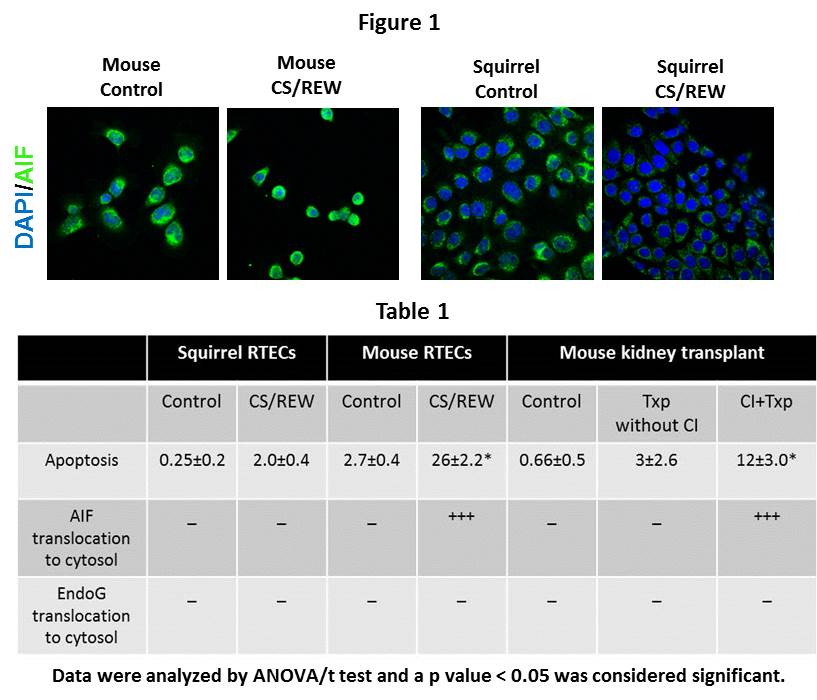Apoptosis during Cold Ischemia and Rewarming Involves a Caspase Independent Pathway
1Renal Division, University of Colorado, Aurora, CO, 2Transplant Microsurgery Program, University of Colorado, Aurora, CO
Meeting: 2019 American Transplant Congress
Abstract number: 280
Keywords: Apoptosis, Kidney transplantation
Session Information
Session Name: Concurrent Session: Ischemia Reperfusion & Organ Rehabilition II
Session Type: Concurrent Session
Date: Monday, June 3, 2019
Session Time: 2:30pm-4:00pm
 Presentation Time: 3:30pm-3:42pm
Presentation Time: 3:30pm-3:42pm
Location: Room 313
*Purpose: We have previously shown that hibernating ground squirrels (GS) tolerate core body temperatures of 4°C for several days with a heart rate that is 1% of normal (Jani, A Transplantation, 2011). The kidneys of the hibernators display no histological injury or renal tubular epithelial cell (RTEC) apoptosis. We have also shown that mouse RTECs subjected to in vitro cold storage at 4°C followed by rewarming (CS/REW), and mouse kidneys subjected to cold storage at 4°C followed by transplantation (CI+Txp) demonstrate significant RTEC apoptosis that can be partially blocked with a pan caspase inhibitor, Q-VD-OPh (Nydam T, Transplantation, 2018). Since Q-VD-OPh only partially blocks apoptosis, we hypothesized that caspase independent apoptosis may be activated during CS/REW and CI+Txp in mice. Furthermore, we hypothesize that GS RTECS are protected from caspase independent apoptosis.
*Methods: GS and mouse RTECs were subjected to cold storage in UW solution followed by rewarming (CS/REW) in normal media as previously described (Jain S, Transplantation, 2015). Donor mice kidneys were subjected to CI followed by kidney transplant (CI+Txp) or transplanted without CI. Apoptosis was quantified by TUNEL assay or morphologically. AIF and Endomuclease G (EndoG) were examined in mitochondrial and cytosolic fractions by immunoblot and IF.
*Results: In vitro experiments: Mouse RTECs exposed to CS/REW had significantly increased apoptosis vs. squirrel RTECs (Table 1). Furthermore, mouse RTECs subjected to CS/REW had significantly increased mitochondrial AIF translocation to the cytosolic fraction vs. squirrel RTECs (Fig 1). In contrast, EndoG translocation could not be detected. Mouse kidney transplant experiments: AIF translocation to the cytosol was detected only in mouse kidneys subjected to CI+Txp, whereas mouse kidneys that were not subjected to CI did not demonstrate cytosolic translocation of AIF. Furthermore, EndoG cytosolic translocation was not detected.
*Conclusions: Our data suggests that hibernators that are capable of surviving several days at 4°C suppress caspase dependent and independent apoptosis. In contrast, in vitro cold storage and cold ischemia followed by transplantation in mice is characterized by both caspase dependent and evidence of caspase-independent apoptosis. The latter is mediated by AIF rather than EndoG. Complete blockade of RTEC apoptosis in clinical transplantation will therefore likely require inhibition of both caspase dependent and independent pathways.
To cite this abstract in AMA style:
Jain S, Plenter R, Nydam T, Jani A. Apoptosis during Cold Ischemia and Rewarming Involves a Caspase Independent Pathway [abstract]. Am J Transplant. 2019; 19 (suppl 3). https://atcmeetingabstracts.com/abstract/apoptosis-during-cold-ischemia-and-rewarming-involves-a-caspase-independent-pathway/. Accessed January 7, 2026.« Back to 2019 American Transplant Congress

